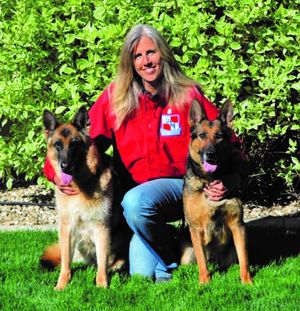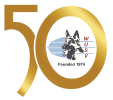Hindquarter Angulation – German Shepherd Dogs

Publication from the USCA Membership Magazine – Issue
By courtesy of Heidi Theis – National Breed Warden
NBW message
This is a difficult subject but as my duty as NBW of the great German Shepherd Dog breed, it has to be discussed. I wish to write to you all about the German Shepherd Dog's increasingly more commonplace, unhealthy, and extreme hindquarter angulation and extreme short/steep upper arms/shoulders. This is a dangerous road where we have gone from a creep to an alarming, steady roll down a slippery slope in producing too much rear angulation and incorrect fronts in our GSD. This is a working breed, and we must maintain it as such through normal conformation as intended by the founder of the breeder, Max von Stephanitz.
Discussing with a long-time breeder, watching heeling or show-ring trotting videos, seeing photos of dogs in the show ring or heeling, and discussing these issues with the other 2 USCA Conformation Judges, MacIntyre and Shook, has collectively prompted me to write another warning to all breeders, show line and working line. These are genetic problems seen in show line and working line dogs. The problems are slightly different amongst show line to working lines dogs though. We are seeing a very pronounced imbalance in the working line dog due to this excess rear and how it connects for movement with the front's bone length and angulation. We are seeing more exaggerated very short and steep upper arms in the working line dog combined with this excessive rear. In the working line dog, this completely altered GSD conformation is not normal and is incorrect. Unfortunately, it has become "popular" because it is producing dogs with head up, high stepping, fast sitting, and flashy heeling.
These types of dogs are being bred to and the normal/correct dog is being dismissed in breeding programs. The show line dog is mostly maintaining correct front angulations because it is necessary for trotting correctly but the rears are becoming more exaggerated and more unstable. In these programs, the normal, strong healthier rears are being dismissed in breeding programs and should be utilized more frequently.
Almost 2 years ago I obtained permission to reprint an article in our magazine as a strong warning about unhealthy hindquarters and yet it sadly continues to be produced. I'd like to refer everyone to this article again that discusses what normal versus over angulation is so that everyone can learn to help correct this genetic problem before it is too late. You can find the hindquarter article in our magazine archives here:
https://www.germanshepherddog.com/wp-content/uploads/2019/03/SchH-USA-March-April-2019-web.pdf (Pages 33-64)
If we continue to ignore over angulation of the rear, we will lose the strong, normal, healthy GSD hindquarters over time, forever. Breeders need to act now and be selective in raising puppies with strong genetic hindquarters and normal front angulation and not the long, over angulated hindquarters. Breeders also need to pay attention to these extreme fronts and avoid over producing this. There is a point where these angulations cross from the absolute borderline of too much, to accentuated/unstable, too short/steep. This borderline is the start of severe weakening of the back and hindquarters and the altered appearance of what the breed should look like.
Problems we conformation and performance judges see that arise from too much rear angulation, incorrect fronts, and/or imbalanced structure include and are not limited to: hocks crossing during normal walking or turning movement, hocks shaking with unsteadiness during heeling exercises, slow speed in running during obedience or protection trial phases, having difficulty finishing an IGP 3 tracking phase, dogs stepping on the entire hock during heeling or trotting in the ring versus on the actual foot where it is supposed to walk, not trotting efficiently in the show ring, not physically being capable of performing jumping exercises with ease as prescribed by our breed tests, and no longer being effective in the rear drive to complete a day's work as a herding dog, the original intention of this breed. We are witnessing more and more of these exaggerated and incorrect fronts and rears. When normal walking is not even present in our young puppies, I believe we have a huge problem on our hands.
I am becoming more and more concerned for the health of our beloved GSD for future generations and also for the public perception of this type of over-angulation. The general public already hates the "sloped" (as they call it) look of the GSD, they think these dogs are in pain. Imagine what the general public would say if they saw a puppy's hocks crossing over each other and getting stuck. This looks crippling, disturbing, and unhealthy to see such exaggerations.
Please take serious consideration to what the front and rear angulations are doing within your breeding programs. Of course, we all know that these issues can and do arise, breeding is not always exact. I would just ask for everyone to strive to make these issues come at more of a minimum through highly selective breeding practices.
Most sincerely,
Heidi Theis
USCA National Breed Warden
